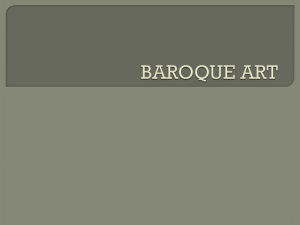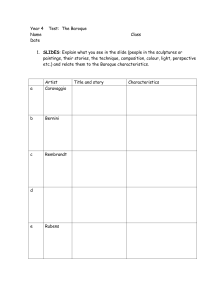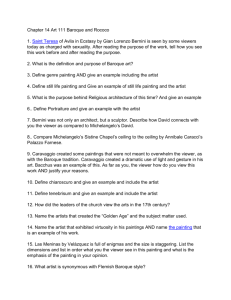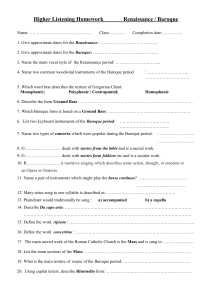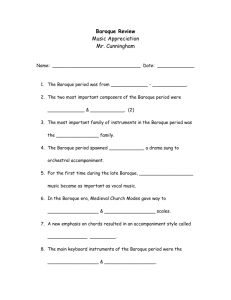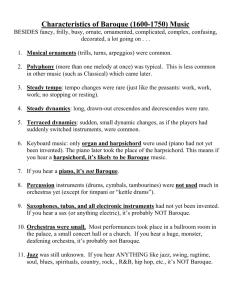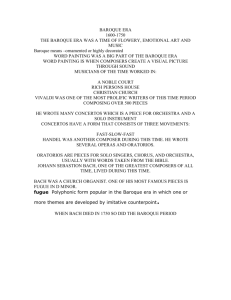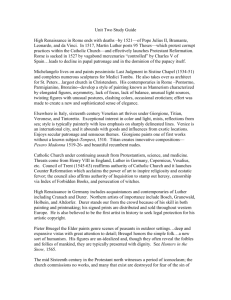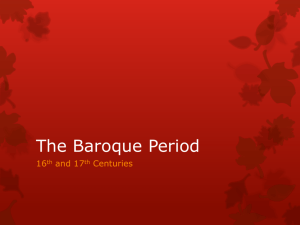Baroque Study Guide
advertisement
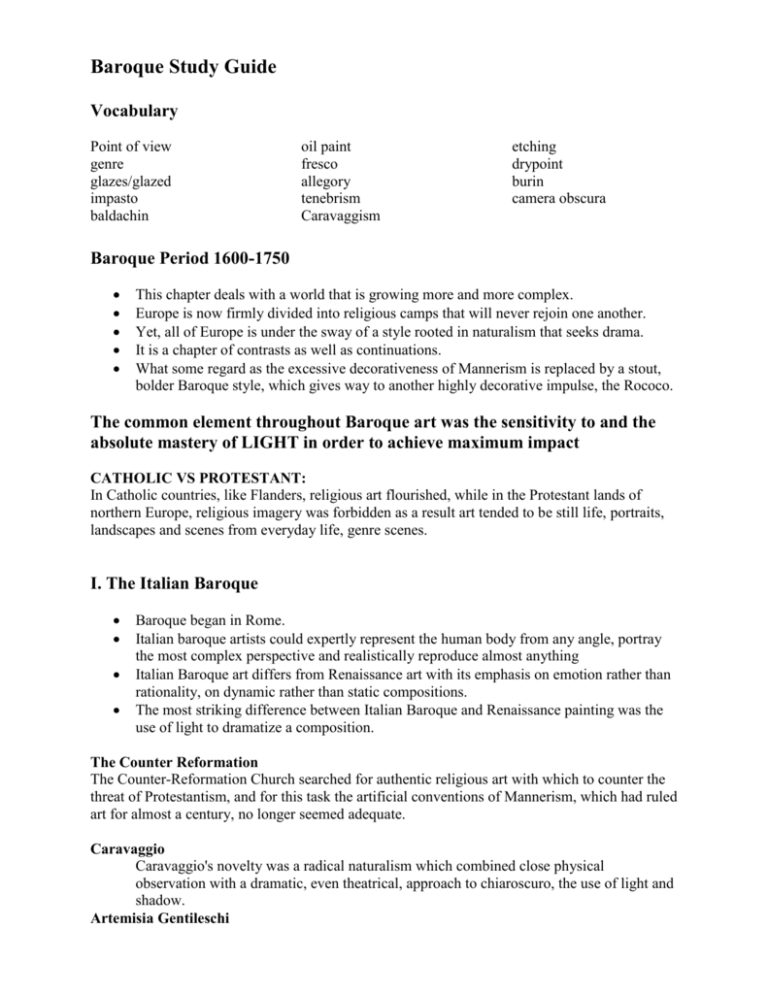
Baroque Study Guide Vocabulary Point of view genre glazes/glazed impasto baldachin oil paint fresco allegory tenebrism Caravaggism etching drypoint burin camera obscura Baroque Period 1600-1750 This chapter deals with a world that is growing more and more complex. Europe is now firmly divided into religious camps that will never rejoin one another. Yet, all of Europe is under the sway of a style rooted in naturalism that seeks drama. It is a chapter of contrasts as well as continuations. What some regard as the excessive decorativeness of Mannerism is replaced by a stout, bolder Baroque style, which gives way to another highly decorative impulse, the Rococo. The common element throughout Baroque art was the sensitivity to and the absolute mastery of LIGHT in order to achieve maximum impact CATHOLIC VS PROTESTANT: In Catholic countries, like Flanders, religious art flourished, while in the Protestant lands of northern Europe, religious imagery was forbidden as a result art tended to be still life, portraits, landscapes and scenes from everyday life, genre scenes. I. The Italian Baroque Baroque began in Rome. Italian baroque artists could expertly represent the human body from any angle, portray the most complex perspective and realistically reproduce almost anything Italian Baroque art differs from Renaissance art with its emphasis on emotion rather than rationality, on dynamic rather than static compositions. The most striking difference between Italian Baroque and Renaissance painting was the use of light to dramatize a composition. The Counter Reformation The Counter-Reformation Church searched for authentic religious art with which to counter the threat of Protestantism, and for this task the artificial conventions of Mannerism, which had ruled art for almost a century, no longer seemed adequate. Caravaggio Caravaggio's novelty was a radical naturalism which combined close physical observation with a dramatic, even theatrical, approach to chiaroscuro, the use of light and shadow. Artemisia Gentileschi Follower of Caravaggio, First well known female artist, presented woman’s point of view Bernini Greatest sculptor of the Baroque period Also an architect, painter, playwright, composer and theater designer. More than any other artist, with his public fountains, religious art, and designs for St Peter’s, he left his mark on the city of Rome Borromini What Caravaggio did for painting Borromini did for architecture. Just as Caravaggio’s figures seem to leap out at the viewer, Borromini’s undulating walls also to come life with dramatic light and shadow. Italian Art Work: Caravaggio o Judith Beheading Holofernes o The Calling of Saint Matthew o Supper at Emmaus o Entombment o Death of the Virgin Genteleschi o Judith Beheading Holofernes o Self-Portrait as the Allegory of Painting o Judith and Her Maidservant Bernini o David o The Baldachin, St Peter’s o The Throne of Saint Peter o The Ecstasy of Saint Therese o Colannade at St. Peter’s Borromini o Façade of San Carlo alle Quartro Fontane II Baroque Art in France In the 17th century, France was the most powerful country in Europe. Louis XIV, the sun king built his lavish palace at Versailles, by Mansart and Le Vau George de la Tour Use of candlelight, simplified compositions, unusual point of view Nicholas Poussin Passionately interested in Classical antiquity, basing many of his paintings on ancient Roman and Greek myths. Claude Lorraine “Landscape Lorraine” Unlike Poussin, Lorrain was not as interested in Classical themes, but was more interested in the natural beauty of the landscape. He was especially interested in the serene light of dawn and dusk. French Art Work: Versailles, Mansart and LeVau o Exterior o Interior Georges de la Tour o Fortune Teller o Magdalen with the Smoking Flame o Christ in the Carpenter's Shop o The New-born o St Sebastian Attended by St Irene Poussin o The Rape of the Sabine Women o Landscape with Saint John on Patmos o Holy Family on the Steps Lorrain o Aeneas's Farewell to Dido in Carthage o Landscape with the Finding of Moses o Landscape with the Rest on the Flight into Egypt o o Baroque Architecture in England 17th cen. architecture in Britain was dominated by, Inigo Jones and Christopher Wren. They replaced the country’s long lived Gothic style with a Classical one. *Need to be able to identify Wren heavily influenced by Bernini, designed St Paul’s Cathedral, London III Baroque in Spain The Spanish kings who ruled throughout the 17th century, reigned over an increasingly weakening empire. However, the 17th century was a rich period for painting and literature, which sometimes concealed the country’s economic and political decline. It was a period of great rebellion, both the Portuguese and the Protestants in the northern Netherlands fought for independence from Spain. Furthermore, what had seemed to be an endless flow of gold and silver from the Americas diminished. Attempting to defend the Roman Catholic Church and their empire on all fronts, Spanish kings squandered their resources and finally went bankrupt in 1692. Spanish Painting 17th century Spanish painting, profoundly influenced by Caravaggio, was characterized by an ecstatic religiosity combined with intense realism whose surface details emerge from the deep shadows of tenebrism. Jusepe de Ribera He explored themes of bloody martyrdom, meant to draw people back to the Catholic Church, but he was equally capable of great tenderness His work is remarkable for his feeling for individual humanity. Indeed, he laid the foundation of that respect for the dignity of the individual which was so important a feature of Spanish art from Velasquez to Goya. Francesco de Zubaran his austere, harsh, hard edged style was unfavorably compared to the sentimental religiosity of Murillo and Zurbaran's reputation declined. Bartolome Murillo Specialized in painting the Virgin Mary and the Immaculate Conception. Murillo followed guidelines from Counter Reformation authorities when painting the Virgin. Mary was to be dressed in blue and white, hands folded in prayer as she is carried to heaven by angels. Mary may be surrounded by an unearthly light and may stand on a crescent moon. Diego Velasquez Spain's most gifted painter was also one of the greatest artists of all time. A master of technique, highly individual in style, He was a master realist, and no painter has surpassed him in the ability to seize essential features and fix them on canvas with a few broad, sure strokes. Spanish Art Work: Jusepe de Ribera o Martyrdom of Saint Bartholemew o Clubfooted Boy Francesco de Zubaran o Saint Serapion Bartolome Murillo o Immaculate Conception o Virgin and Child o A Girl and her Duenna Diego Velasquez Old Woman Frying Eggs o The Waterseller of Seville o The Surrender of Breda (The Lances) o Las Meninas (The Maids of Honor) o Portrait of Innocent X o Venus at her Mirror IV Baroque Art Netherlands Southern Netherlands/ Flanders/ Catholic o The southern Netherlands, called Flanders and later Belgium, remained Catholic after the Reformation. o This gave artists ample incentive to produce both secular and religious paintings. o After nearly a century of conflict with their Spanish rulers, Flanders won independence in the early 17th century. Peter Paul Rubens High energy was the secret to Rubens life and art. His work explodes with a flurry of brushstrokes. Worked primarily from life, unlike many of his contemporaries who worked from plaster casts. Rich, luscious colors Full bodied, sensuous nudes Warm, luminous flesh tones Anthony van Dyck Was an accomplished painter at 16, and worked briefly for Rubens. Moved to England where he became court painter to Charles I He became addicted to high society, dressing ostentatiously and carrying a sword. A supreme portraitist, he created the informal, formal portrait Northern Netherlands/ Holland/ Protestant Although Holland shared its southern border with Flanders, culturally and politically the two countries could not have been more different. While the monarchy and the Church dominated Flanders, Holland was an independent, democratic Protestant country. Religious art was forbidden, and the usually sources of patronage, the Church and the monarchy no linger existed. The result was a democratizing of art in both subject matter and ownership. Artists were at the mercy of the marketplace, and had to create paintings that would appeal to the rising middle class. Luckily Holland’s prosperous middle class was very interested in purchasing and collecting art. Dutch artists produced highly detailed genre paintings, portraits, still lifes, landscapes, and interior scenes. Frans Hals Master of capturing the moment in an expression or gesture. His paintings are full of flamboyant brushwork Judith Leyster Successful contemporary of Hals, best known for her scenes of every day life. Influenced also by Italian artists who had studied the work of Caravaggio. Rembrandt van Rijn Be able to describe his change in style During his lifetime, Rembrandt was an extremely successful portrait painter. Today his reputation rests principally on the introspective painting of his later years. During the first 20 years of his career, Rembrandt’s portraits were in great demand, he also painted biblical and historical scenes in the Baroque style. Later works, beginning w/ the Night Watch in 1642, reflect a marked change in his style His beloved wife had died and he had already lost three children in infancy. A palette of rich reds and browns began to dominate his paintings, as did solitary figures and a pervasive theme of loneliness. He pushed the limits of chiaroscuro, using gradations of light and dark to convey mood, character and emotion. Jan Vermeer Dutch genre painter lived and worked in Delft, and created some of the most exquisite paintings in Western art. But little is known of his life and work Of the 35 or 36 paintings generally attributed to him, most portray figures in interiors. All his works are admired for the sensitivity with which he rendered effects of light and color and for the poetic quality of his images. No painter, except for perhaps van Eyck or van der Weyden, was as skilled as Vermeer in his masterful use of light. Vermeer’s colors were brighter, purer, and glowed with an intensity unknown before. In addition to his expert handling of color and light, Vermeer was a master of perfectly balanced compositions. His handling of paint was also revolutionary, applying paint in dabs and dots so that the raised surface of the paint reflected more light. One critic described his paint surface as “crushed pearls melted together” He died bankrupt at the age of 43. Dutch and Flemish Art Works: Rubens o Raising of the Cross o Rape of the Daughters of Leucippus o The Rape of Europa Van Dyck o Portrait of Charles I Hunting Hals o The Merry Drinker1628-30 Leyster o Self Portrait Rembrandt o The Jewish Bride o Hendrickje in Bed o Sampling Officials of the Drapers' Guild o The Night Watch o Self-Portrait1658 Vermeer o The Milkmaid o The Young Woman with a Water Jug o Woman in Blue Reading a Letter o The Girl with Pearl Earring o The Love Letter o The Allegory of Painting
